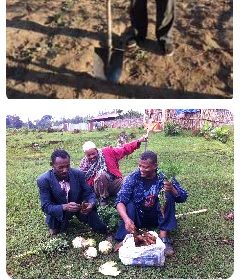When it comes to preventing disability in water and agricultural management there are two important strategies: (1) prevention of waterborne diseases and (2) prevention of occupational hazards.
Prevention of waterborne diseases
Water can be a cause of disability as a result of microbiological contamination (through bacteria, viruses or protozoa, enteric fevers and worm infestation) or chemical contamination (through for example high fluoride and arsenic levels). Contamination could happen during bathing, washing, drinking, while preparing food or through the consumption of infected food. Examples of these waterborne diseases include malaria, bilharzia, polio, cholera, dengue, and fluorosis.
The availability of safe and sufficient water can reduce the suffering of many people. Clean water can be ensured by selecting water sources that are not contaminated or by removing contaminants through water treatment.
Yet, the provision of clean water may not be sufficient. Water from point water sources such as handpumps will be transported from the source to the point of storage at homes. This implies a considerable risk of contamination during transport and storage that depends on the “water culture” of the users.
The famous f-diagram shows how measures contribute to completely break the transmission of pathogens from feces to faces. For example, storing water safely by covering a bucket.
Prevention of occupational hazards
Agriculture comes with occupational hazards that are often ignored but could be a cause of disability too, especially for the poor who work in less protected environments. Occupational hazards are risks that workers encounter, physically or mentally, while doing their job.
In agriculture, accidents can happen while working with heavy machinery, applying pesticide, threshing grain and cutting chaff cutting. Also snakebites and heat illness could be a hazard when working in the field.
Safety interventions
The International Labour Organization developed a code of practice on safety and health in agriculture, which provides practical guidance and technical standards for the agricultural sector. The code is non-binding, but helpful for those who wish to implement safety interventions.
In the USA, tractor accidents are the leading source of death and injuries on the farm. The national agricultural tractor safety initiative promotes using Rollover Protecting Structures, seatbelts and machine guards. They calculated that costs are comparable to other public health safety interventions such as the mandatory airbags.
Another measure taken in the USA is to prevent health issues caused by a lack of drinking water and sanitation facilities. Regulations are written down in the Field Sanitation Standard, which applies to any agricultural establishment where eleven or more workers are in hand-labor operations in the field. The standards require employers to provide: toilets, potable drinking water, and hand-washing facilities and to provide each worker reasonable use of it. It also mentions that the employer is obliged to inform each worker of the importance of good hygiene practices.
Related Videos



